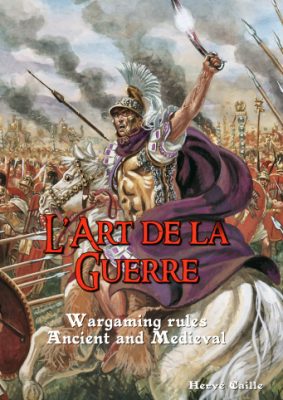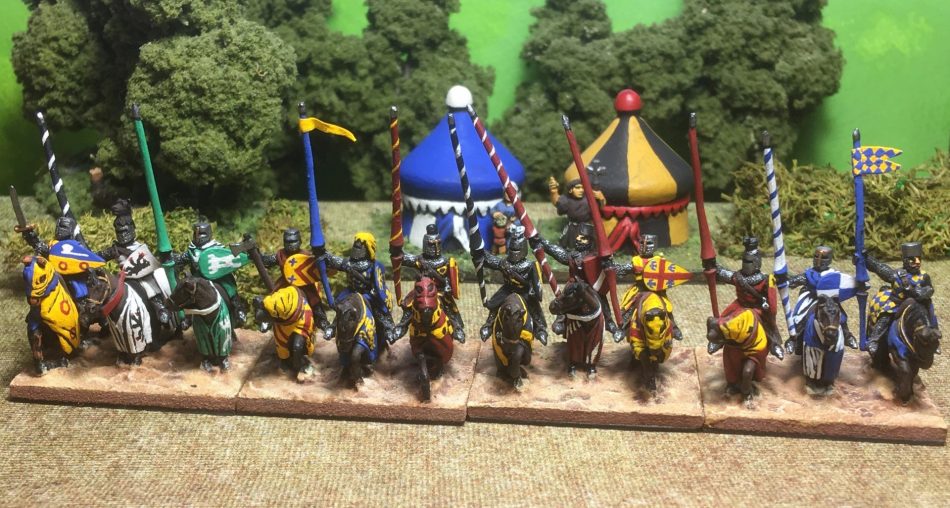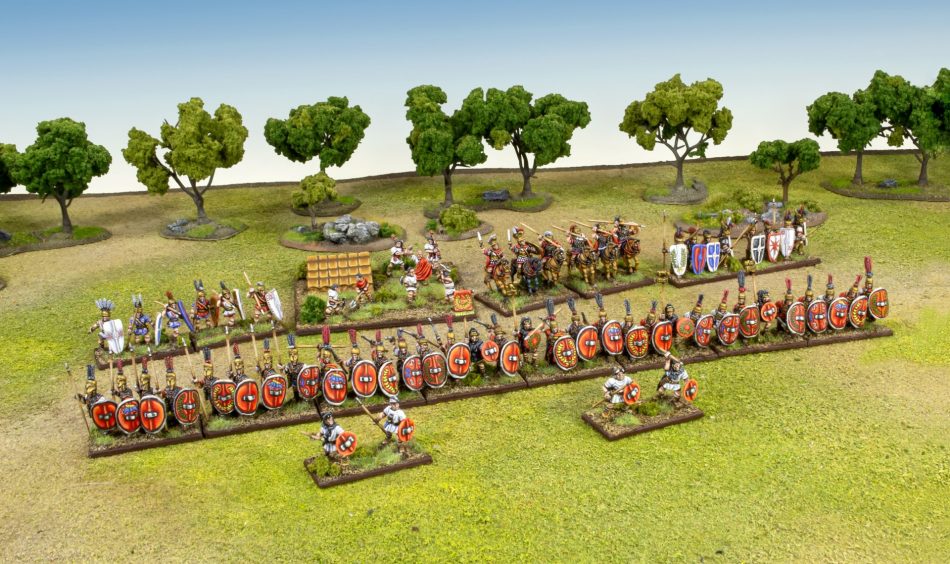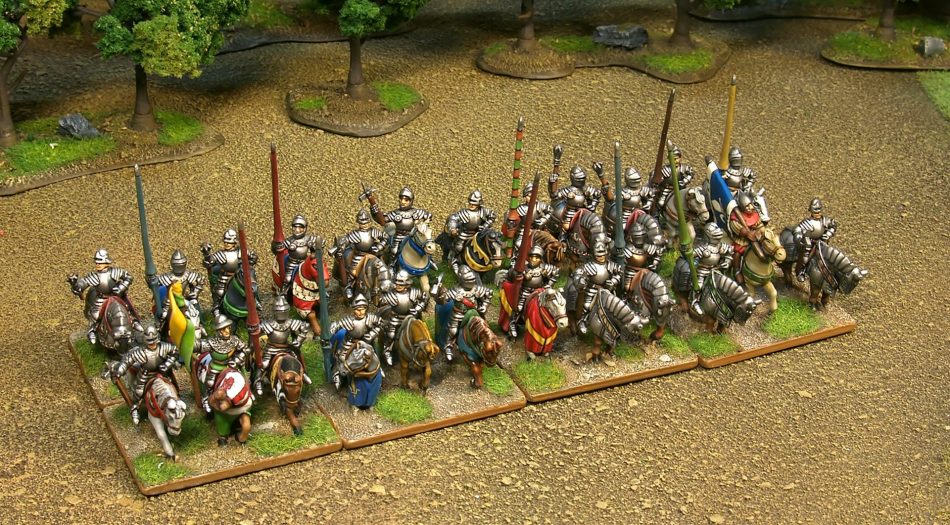L’art De La Guerre, the new Version (v4) explained by the Author, Hervé Caille
 By Paolo Paglianti
By Paolo Paglianti
One of the most played “ancient” and “medieval” ruleset, L’Art De La Guerre (ADG), is getting a new version later this month. Easy to play but deep and difficult to master, ADG has a very well-written (and well translated in English, Italian, Spanish, and French) manual, with a lot of examples that clarify almost all situations.
Most players use 15mm armies, but you can play also with 6mm or 28mm. The already good and smooth rules now get an improvement, made listening to the feedback from players all around the world. NoDiceNoGlory didn’t miss the opportunity to sit down with the author and have a chat about the incoming changes. Who better than the author, Hervé Caille, can explain the new changes?
First, things firsts: you can find info about L’Art De La Guerre on the official site: . This is the main resource to find news and advice on how to play the game, or the preorder the ruleset of the new V4 version, which will be available later in April. If you live in Europe, you can preorder the ruleset also on
Why did you choose to have a new edition? is it based on the thousands of games played with older versions?
This is now the fourth edition of the rules. The first one was published in 2008, the second in 2010, and the third in 2014. The third edition was translated into English and Spanish. The fourth edition will be available in French, English, Spanish and Italian. For version 4, in-depth work was conducted to improve the game. The players’ suggestions and numerous tests have improved the rule on several points and clarified or simplified other ones. It was really a collaborative work with players from different countries (France, England, USA, Spain, and Italy).
What about the new unit types?
In V4, I try to add all very specific units that bring some chrome to the game. It appears that players like these kinds of units as it allows to paint some very specifics figs. War wagons with blades represent wagons equipped with blades, pikes, and hooks used against mounted troops or elephants by Camillan Roman, Classical Indian, and Communal Italian. These are very specific troops:
– They do not shoot as other WWg.
– They can charge or contact the enemy and conform, but cannot pursue.
– Combat factor of +2 against elephants and they cancel the Impact ability of elephants.
– Budget is 8 pts
Incendiary light foot represents light infantry units armed with grenades, flame throwers, and pots of flaming Naphtha (called “naffatun”). These troops were used by Byzantines, Arab, and some Chinese armies.
– They fire at 1 UD (UD is the basic distance in ADG, 4 cm) and their target has no protection (except LI and LH).
– They also have a +1 bonus in melee and shooting against Elephants and WWg.
– Budget of 5 pts.
 Some Heavy Knights emerging from the vulnerable baggage and ready to charge (© Cédric Roudil)
Some Heavy Knights emerging from the vulnerable baggage and ready to charge (© Cédric Roudil)
Romans now have also the light artillery “inside” their legions. how does it work? Any other list will have them?
Light artillery is upgraded in V4 as it can now move and shoot on the same turn. Light artillery integrated represents the ability to use artillery in coordination with infantry. During Empire, a Roman legion aligned 60 scorpions (one per century). It is represented by light artillery that can shoot over legionaries or auxiliaries if placed just behind. It gives to roman some fire capability for a budget of 7 pts per artillery unit. Some other armies can have integrated light artillery: German during Batavian Revolt, Palmyran, Ming Chinese, and Korean Yi.
Speaking of lists, did you change the lists from old version?
Yes, all lists have been reviewed and most have been modified. There are more options and variety and some lists have been improved to becomes more interesting. The dates of the allies have been specified. Some of the background material has been rewritten and refined. There are also more Strategist Generals than in V3.
 Deep infantry lines ready for battle, with the comfortable sight of an allied Elephant to counter mounted enemies (© )
Deep infantry lines ready for battle, with the comfortable sight of an allied Elephant to counter mounted enemies (© )
Any new list, maybe created splitting some old lists?
There are now 300 lists instead of 273. Some lists have been split into 2 or 3 and others have changed datelines. Some of them are entirely new. Here are the 18 new lists:
Yayoi Japanese
Post Roman British
Later Scots-Irish
Later Pictish
Astur-Leónese and Navarrese
Rebel Vietnamese
Heian Japanese
Feudal Welsh
Konstantinan Byzantine
Taifa Kingdoms
African Kingdoms
Feudal Scandinavian
Medieval Anglo-Irish
Medieval Teutonic
Medieval Cyprus
Vijayanagar Kingdom
Olmec
Polynesian and Melanesian
Note: Forest Indian and Plains Indian lists have been combined into a single list : North American Tribes.
One of the best things from ADG compared to other Ancient and Medieval ruleset is the division in period- geographic zones. did you keep it? did you add any zone?
Of course, we keep it. Some lists have been moved from one period to another for more consistency. All lists in the Feudal period now include only medium knights. Heavy knights are only present in the Medieval period. The Dark Ages period has no knights. This ensures more balanced games for historical tournaments.
We also know contacting the enemy on the flank or the rear is now even more devastating. Would this speed up the game?
It was a request from players to have a greater effect for flank or rear attacks. In the previous version, a unit in support on the flank/rear gives a +1 bonus to the main unit. In V4, it gives a +1 and add also its combat factor so it can give a bonus from +1 to +3. It will speed up the game a little bit as flank attacks are indeed more effective.
 In ADG there are lots of Roman lists, one for each sub-period – from the Republican times to the Fall of the Empire (© )
In ADG there are lots of Roman lists, one for each sub-period – from the Republican times to the Fall of the Empire (© )
What is your favorite army in ADG, and why?
My first army was Justinian Byzantine but I have now many different armies. I like to change and try different armies. For the moment I’m focusing on Pecheneg, Rus and Numidian armies plus another one that is secret for the moment …
Can you give some advice to the player who wants to start playing ADG. Which army to start? Why ADG, in your opinion, is better than other rulesets for playing fun and deep games?
ADG is right now one of the most played ancient and medieval rulesets all over the world. A new player will be sure to found some partners to play with. There is a strong international tournament circuit and we hope that it will restart when the health situation returns to normal. The main advantage of ADG is that game can be played in less than two hours and requires about half the miniatures used in most other rules. You can paint an army quickly and have several ones to try new strategies. The Internet web site contains playing aids, advice and a forum to contact other players.
 A splendid battlegroup of Knights of the late Medieval, with their shining armours and heavy lances (© )
A splendid battlegroup of Knights of the late Medieval, with their shining armours and heavy lances (© )

It’s ADLG to pretty much everyone – if you want to find more resources, like Madaxeman’s wiki and the private Facebook discussion group – search ADLG
Hi, you’re right. Here is the link-> https://www.madaxeman.com/
Nice interview – thanks!
Managed to obtain a copy of v3 a few weeks back and was very impressed – seems well-balanced and scalable. Have pre-ordered v4 and really looking forward to getting back into ancient wargaming after a break of many years!
thanks 🙂
I appreciate the informative article and am eagerly anticipating the arrival of my copy of V4. V3 has been great fun and believe V4 will add interesting opportunities.
Nicely done Paolo, many thanks. It’s been a long time since DBM Milano Dec 2005. Frank says Hi. Hope to see you again. Cheers, Hop
thanks for compliments and see you soon at some tournament around, I hope 🙂